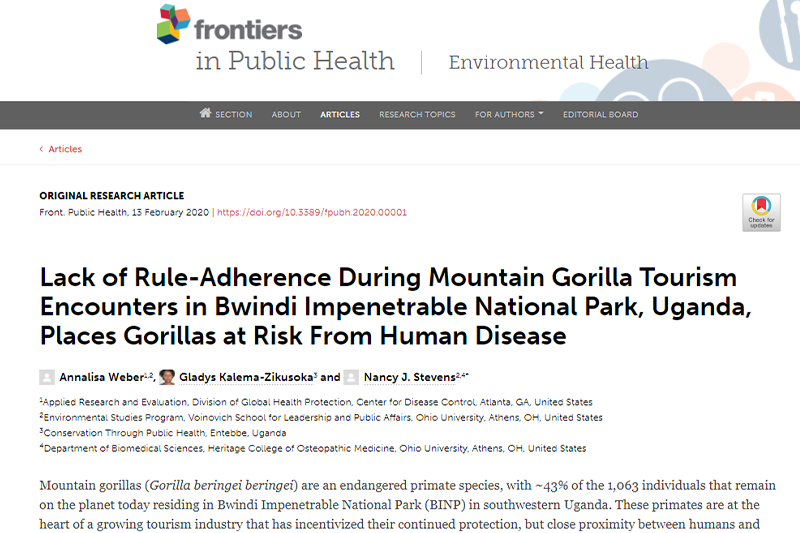
Study by Voinovich School alumna published in Frontiers in Public Health

Field work by Master of Science in Environmental Studies alumna is featured in a paper published recently in the journal Frontiers in Public Health. The paper, “Lack of Rule-Adherence During Mountain Gorilla Tourism Encounters in Bwindi Impenetrable National Park, Uganda, Places Gorillas at Risk From Human Disease” discusses how humans put already endangered mountain gorillas in Uganda at risk of disease transmission during tourism encounters.
Annalisa Weber, who received her MSES in 2015, began working on the project during her graduate studies. Weber is the primary author, with co-authors Nancy J. Stevens, professor of functional morphology and vertebrate paleontology in Ohio University’s Heritage College of Osteopathic Medicine, and Gladys Kalema-Zikusoka, CEO of Conservation Through Public Health.
During the high tourism season in Bwindi Impenetrable National Park, the researchers documented tourist-gorilla spacing in 53 treks. They found that the seven-meter distance rule was violated in over 98% of the tours, even though 96% of the pre-trek briefings by park rangers emphasized the need to maintain a greater than seven-meter distance.
“Although I had heard tourists were getting too close to the gorillas, I was surprised by the extent of the problem,” said Weber in a blog published by Frontiers in Public Health about the research. “We found that seven-meter rule was violated in visits to all of the gorilla groups habituated at the time of the study. And in 14% of observations, human-gorilla spacing was three meters or less.”
The researchers collected observational data at two-minute intervals during gorilla-viewing tourism encounters and documented that nearly 70% of all observations took place at a distance less than or equal to seven meters.
“As tourism increases, and gorillas become increasingly habituated to human presence, new strategies will be needed for endangered great ape populations to thrive into the future,” Stevens said in the blog. “Fortunately, we have talked with many insightful and empowered park officials who are poised to take action to protect gorilla health.”
Abstract:
Mountain gorillas (Gorilla beringei beringei) are an endangered primate species, with ~43% of the 1,063 individuals that remain on the planet today residing in Bwindi Impenetrable National Park (BINP) in southwestern Uganda. These primates are at the heart of a growing tourism industry that has incentivized their continued protection, but close proximity between humans and gorillas during such encounters presents well-documented risks for disease transmission. The Uganda Wildlife Authority (UWA) has developed rules to help protect the health of the gorillas, limiting each habituated gorilla group to a single 60 min visit each day by a group of no more than 8 tourists, and emphasizing that humans maintain a >7 m distance from gorillas at all times. A number of studies have documented that not all tour groups respect these rules. This project assesses rule-adherence during gorilla tourism encounters at BINP using both observational and survey-based data collected during the tourism high season between May and August, 2014. Observational data from 53 treks reveal that groups of 1–11 tourists engaged in gorilla viewing encounters between 46 and 98 min in duration. Although 96% of pre-trek briefings conducted by park rangers emphasized the need to maintain >7 m human-gorilla spacing, the 7 m distance rule was violated in over 98% (52 out of 53) of the tours examined in this study. Observational data were collected at 2 min intervals during gorilla-viewing encounters, documenting the nearest distance between any tourist and a gorilla (n = 1,604), of which 1,094 observations (68.2%) took place at a distance less than or equal to 7 m. Importantly, the 7 m rule was violated in visits to all of the gorilla groups habituated during the time of the study. In 224 observations (~14%, per 1,604 total), human-gorilla spacing was 3 m or less. Survey data (n = 243) revealed promising opportunities to improve tourist understanding of and adherence to park rules, with 73.6% of respondents indicating that they would be willing to utilize a precautionary measure of wearing a face-mask during encounters to protect gorilla health.